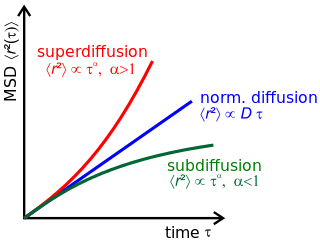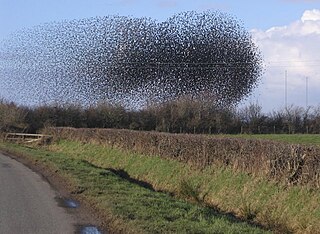
Kenneth Geddes "Ken" Wilson was an American theoretical physicist and a pioneer in using computers for studying particle physics. He was awarded the 1982 Nobel Prize in Physics for his work on phase transitions—illuminating the subtle essence of phenomena like melting ice and emerging magnetism. It was embodied in his fundamental work on the renormalization group.

Diffusion-limited aggregation (DLA) is the process whereby particles undergoing a random walk due to Brownian motion cluster together to form aggregates of such particles. This theory, proposed by T.A. Witten Jr. and L.M. Sander in 1981, is applicable to aggregation in any system where diffusion is the primary means of transport in the system. DLA can be observed in many systems such as electrodeposition, Hele-Shaw flow, mineral deposits, and dielectric breakdown.

Sir John Brian Pendry, is an English theoretical physicist known for his research into refractive indices and creation of the first practical "Invisibility Cloak". He is a professor of theoretical solid state physics at Imperial College London where he was head of the department of physics (1998–2001) and principal of the faculty of physical sciences (2001–2002). He is an honorary fellow of Downing College, Cambridge, and an IEEE fellow. He received the Kavli Prize in Nanoscience "for transformative contributions to the field of nano-optics that have broken long-held beliefs about the limitations of the resolution limits of optical microscopy and imaging.", together with Stefan Hell, and Thomas Ebbesen, in 2014.
The Eden growth model describes the growth of specific types of clusters such as bacterial colonies and deposition of materials. These clusters grow by random accumulation of material on their boundary. These are also an example of a surface fractal. The model, named after Murray Eden, was first described in 1961 as a way of studying biological growth, and was simulated on a computer for clusters up to about 32,000 cells. By the mid-1980s, clusters with a billion cells had been grown, and a slight anisotropy had been observed.

Anomalous diffusion is a diffusion process with a non-linear relationship between the mean squared displacement (MSD), , and time. This behavior is in stark contrast to Brownian motion, the typical diffusion process described by Einstein and Smoluchowski, where the MSD is linear in time.
Luciano Pietronero is an Italian physicist and full professor at the department of Physics at the Sapienza University of Rome. He is also Director of the Institute of Complex Systems of the National Research Council.
Daniel Amihud Lidar is the holder of the Viterbi Professorship of Engineering at the University of Southern California, where he is a professor of electrical engineering, chemistry, physics & astronomy. He is the director and co-founder of the USC Center for Quantum Information Science & Technology (CQIST), the director of the USC-IBM Quantum Innovation Center, as well as scientific director of the USC-Lockheed Martin Quantum Computing Center, notable for his research on control of quantum systems and quantum information processing.

A colloidal crystal is an ordered array of colloidal particles and fine grained materials analogous to a standard crystal whose repeating subunits are atoms or molecules. A natural example of this phenomenon can be found in the gem opal, where spheres of silica assume a close-packed locally periodic structure under moderate compression. Bulk properties of a colloidal crystal depend on composition, particle size, packing arrangement, and degree of regularity. Applications include photonics, materials processing, and the study of self-assembly and phase transitions.

Active matter is matter composed of large numbers of active "agents", each of which consumes energy in order to move or to exert mechanical forces. Such systems are intrinsically out of thermal equilibrium. Unlike thermal systems relaxing towards equilibrium and systems with boundary conditions imposing steady currents, active matter systems break time reversal symmetry because energy is being continually dissipated by the individual constituents. Most examples of active matter are biological in origin and span all the scales of the living, from bacteria and self-organising bio-polymers such as microtubules and actin, to schools of fish and flocks of birds. However, a great deal of current experimental work is devoted to synthetic systems such as artificial self-propelled particles. Active matter is a relatively new material classification in soft matter: the most extensively studied model, the Vicsek model, dates from 1995.
Peter Grassberger is a retired professor who worked in statistical and particle physics. He made contributions to chaos theory, where he introduced the idea of correlation dimension, a means of measuring a type of fractal dimension of the strange attractor.
Differential dynamic microscopy (DDM) is an optical technique that allows performing light scattering experiments by means of a simple optical microscope. DDM is suitable for typical soft materials such as for instance liquids or gels made of colloids, polymers and liquid crystals but also for biological materials like bacteria and cells.
Thomas Witten is an American theoretical physicist working in the field of soft matter physics.
Many experimental realizations of self-propelled particles exhibit a strong tendency to aggregate and form clusters, whose dynamics are much richer than those of passive colloids. These aggregates of particles form for a variety of reasons, from chemical gradients to magnetic and ultrasonic fields. Self-propelled enzyme motors and synthetic nanomotors also exhibit clustering effects in the form of chemotaxis. Chemotaxis is a form of collective motion of biological or non-biological particles toward a fuel source or away from a threat, as observed experimentally in enzyme diffusion and also synthetic chemotaxis or phototaxis. In addition to irreversible schooling, self-propelled particles also display reversible collective motion, such as predator–prey behavior and oscillatory clustering and dispersion.

Fiber network mechanics is a subject within physics and mechanics that deals with the deformation of networks made by the connection of slender fibers,. Fiber networks are used to model the mechanics of fibrous materials such as biopolymer networks and paper products. Depending on the mechanical behavior of individual filaments, the networks may be composed of mechanical elements such as Hookean springs, Euler-Bernoulli beams, and worm-like chains. The field of fiber network mechanics is closely related to the mechanical analysis of frame structures, granular materials, critical phenomena, and lattice dynamics.

Maria Cristina Marchetti is an Italian-born, American theoretical physicist specializing in statistical physics and condensed matter physics. In 2019, she received the Leo P. Kadanoff Prize of the American Physical Society. She held the William R. Kenan, Jr. Distinguished Professorship of Physics at Syracuse University, where she was the director of the Soft and Living Matter program, and chaired the department 2007–2010. She is currently Professor of Physics at the University of California, Santa Barbara.

Mogens Høgh Jensen is a Danish physicist who has made contributions to the fields of complex dynamics and fractals. He currently holds a professorship at the Niels Bohr Institute, University of Copenhagen and is the former president and secretary general of the Royal Danish Academy of Science and Letters.

Amnon Aharony is an Israeli Professor (Emeritus) of Physics in the School of Physics and Astronomy at Tel Aviv University, Israel and in the Physics Department of Ben Gurion University of the Negev, Israel. After years of research on statistical physics, his current research focuses on condensed matter theory, especially in mesoscopic physics and spintronics. He is a member of the Israel Academy of Sciences and Humanities, a Foreign Honorary Member of the American Academy of Arts and Sciences and of several other academies. He also received several prizes, including the Rothschild Prize in Physical Sciences, and the Gunnar Randers Research Prize, awarded every other year by the King of Norway.
An active Brownian particle (ABP) is a model of self-propelled motion in a dissipative environment. It is a nonequilibrium generalization of a Brownian particle.
Robert Everett Ecke is an American experimental physicist who is a laboratory fellow and director emeritus of the Center for Nonlinear Studies (CNLS) at Los Alamos National Laboratory and Affiliate Professor of Physics at the University of Washington. His research has included chaotic nonlinear dynamics, pattern formation, rotating Rayleigh-Bénard convection, two-dimensional turbulence, granular materials, and stratified flows. He is a Fellow of the American Physical Society (APS) and of the American Association for the Advancement of Science (AAAS), was chair of the APS Topical Group on Statistical and Nonlinear Physics, served in numerous roles in the APS Division of Fluid Dynamics, and was the Secretary of the Physics Section of the AAAS.









